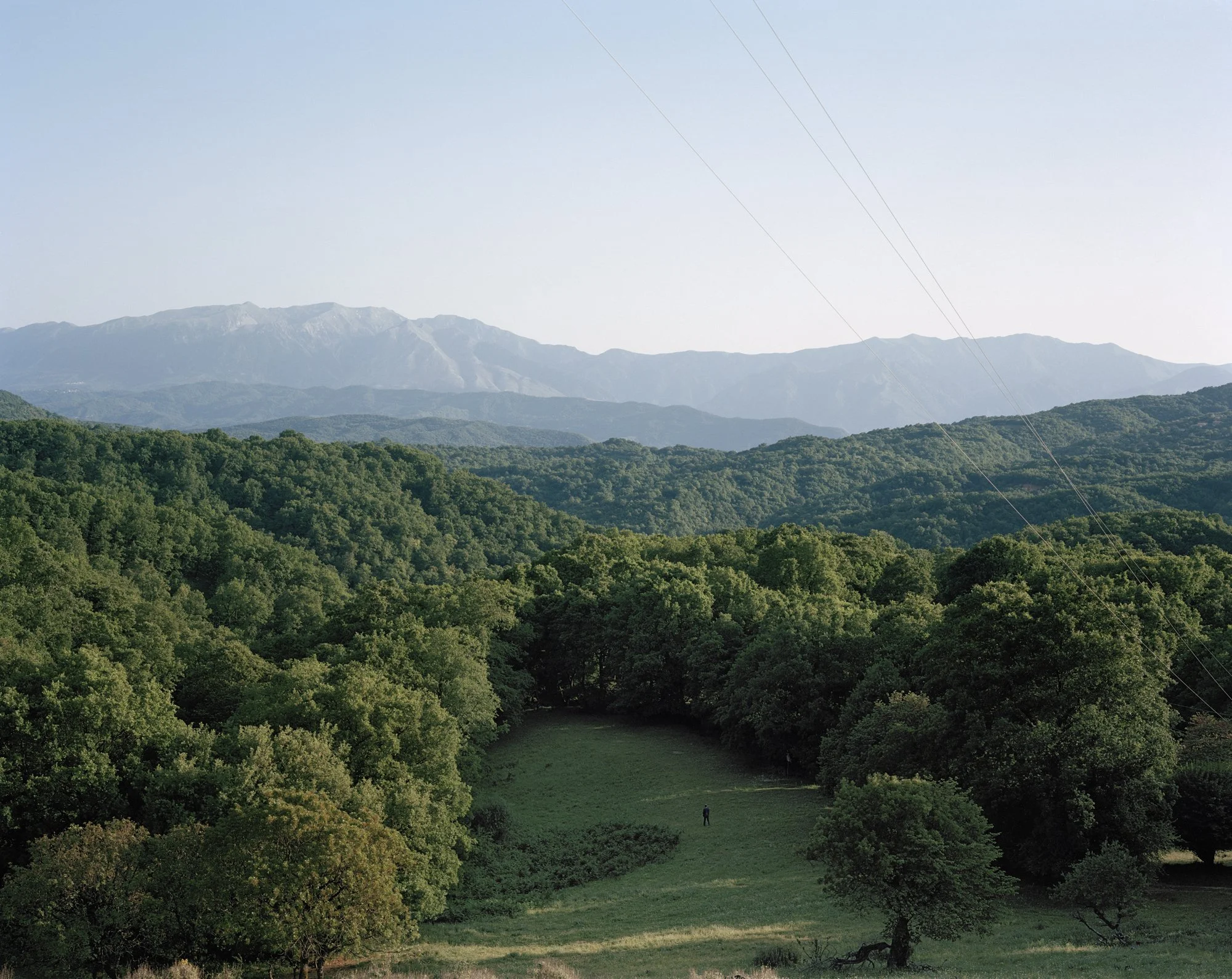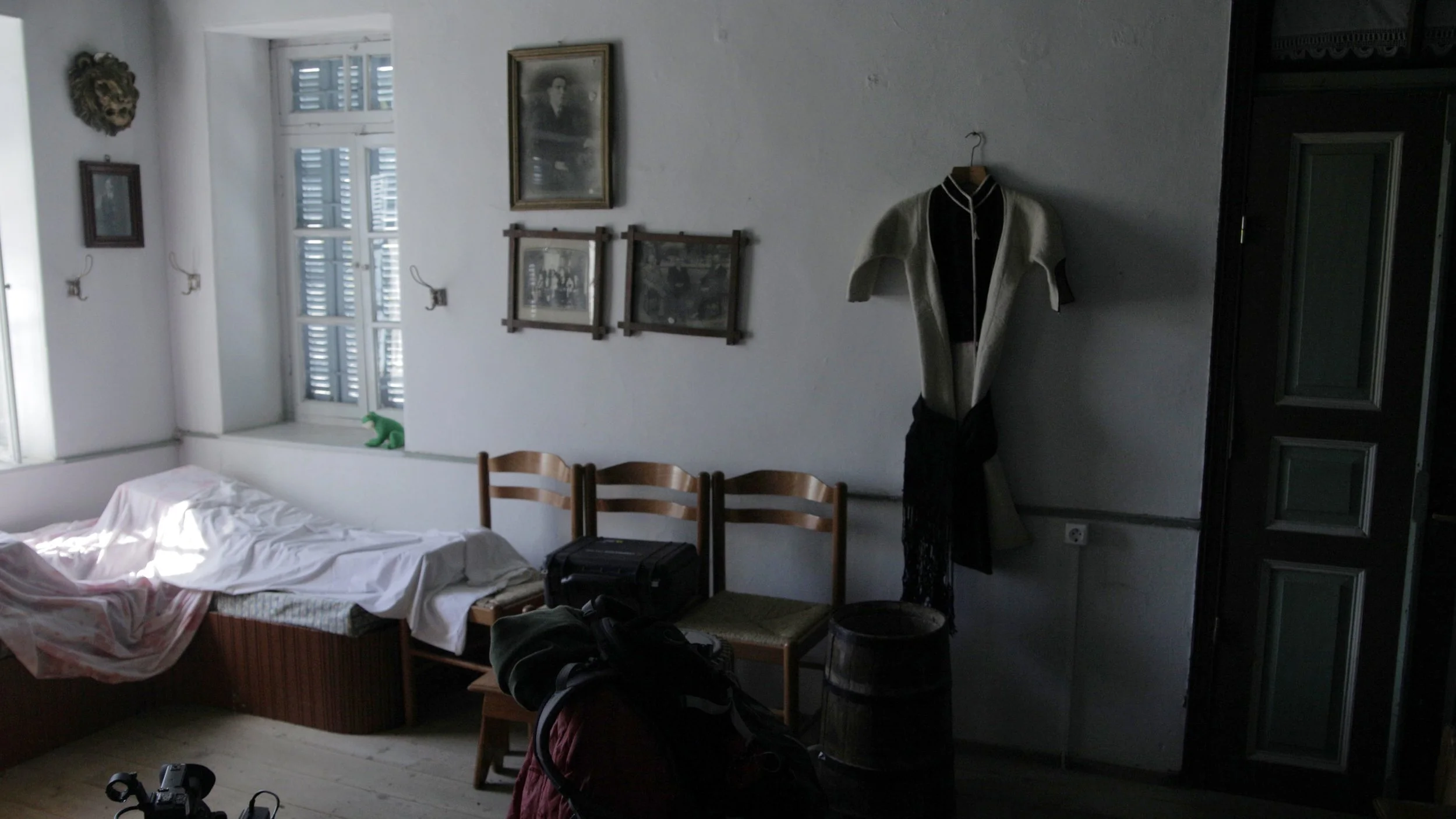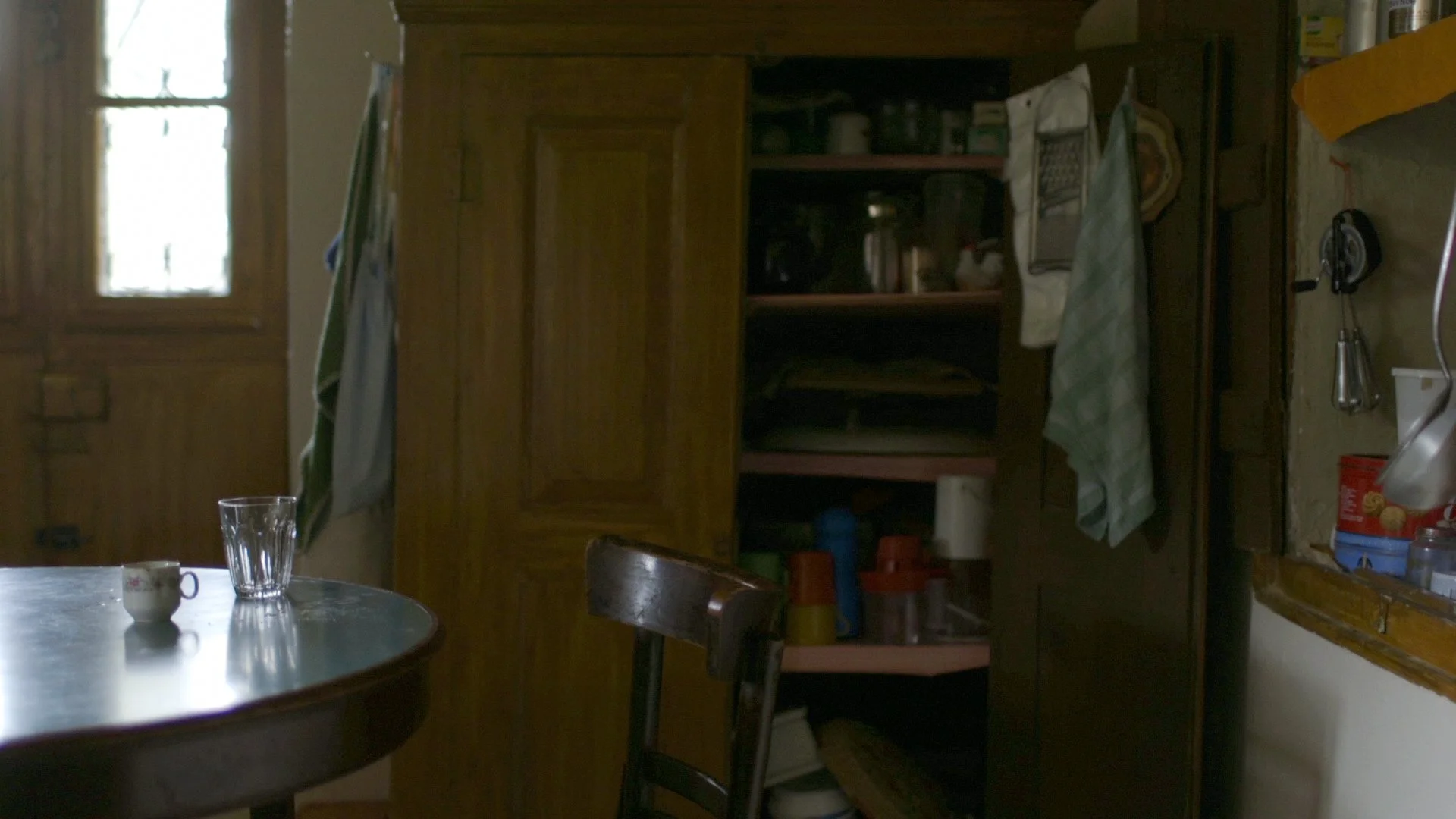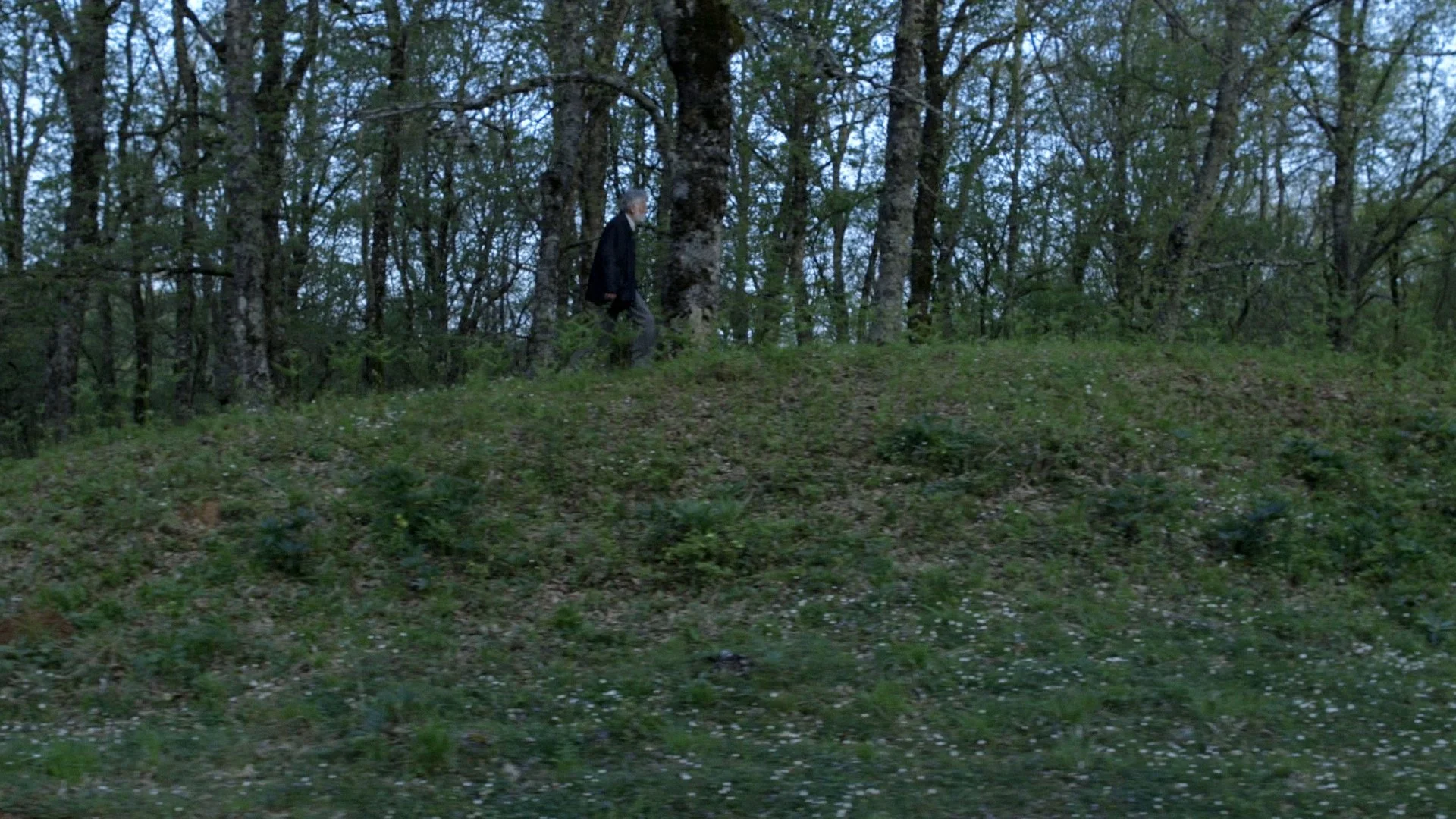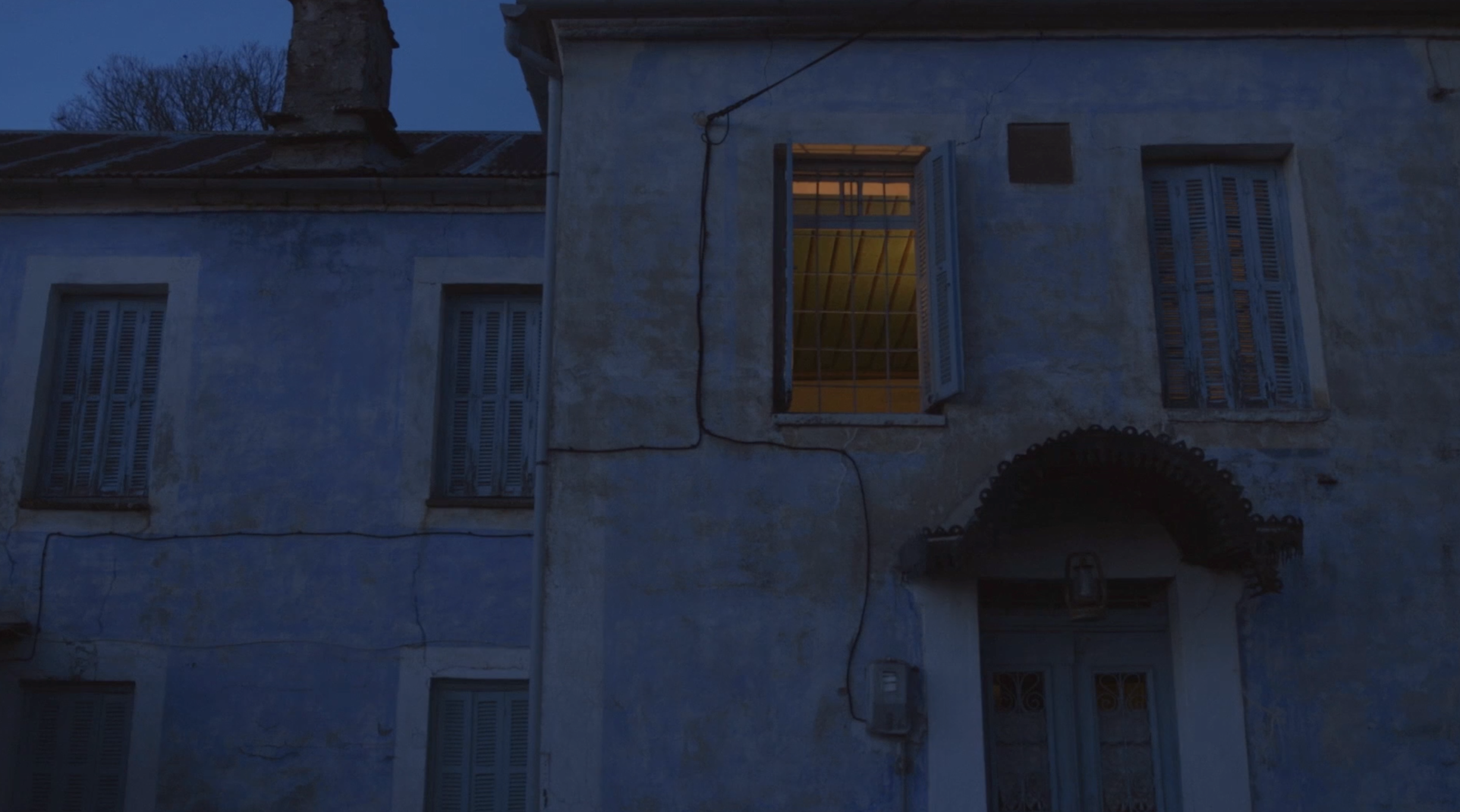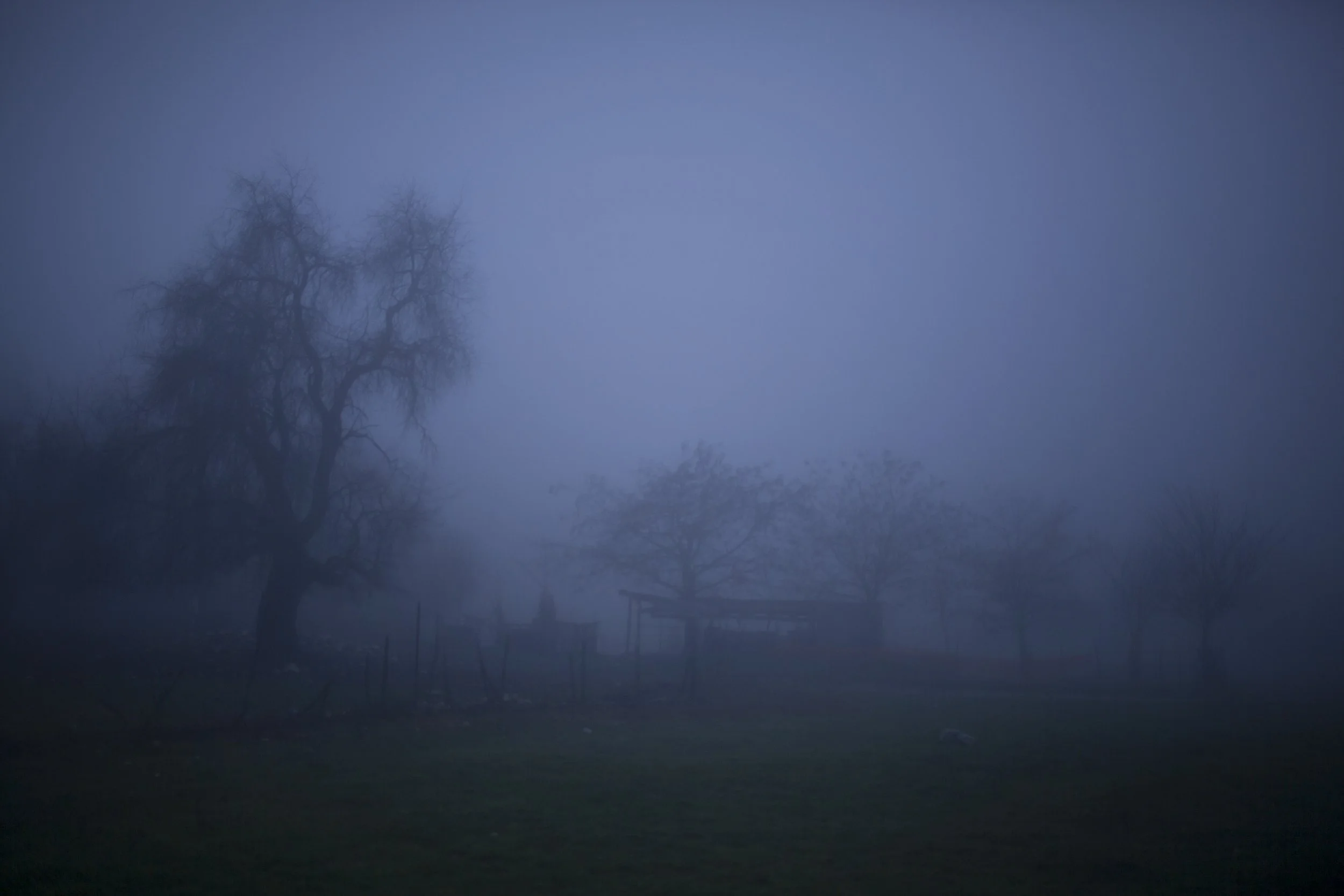The Dialectic of Mountains ◯ Avrilios Karakostas’ Nemércka
Landscape portrait from the production of Nemércka (2016) © Kostas Kapsianis
The primal bend and curvature of Nemércka, a mountain cordillera spanning the border between Albania and Greece, resembles a sleeping woman. Avrilios Karakostas surrenders to the complex origin of this image in his debut short film Nemércka (13”, 2016). In the film, the mountain transforms into an axis where the polyphonic laments of the region are soldered and materialized. As Karakostas contends, “Throughout the film, death functions as a constant, while life is a continuous form of movement.” Athens Design Forum invites Karakostas to revisit the film’s infrastructure, positioning the production archives as records of independent filmmaking that expose new ways of understanding the human condition. Coalescing resources from location scouting and the set design process, the film becomes a medium of entry into the spatial parameters of loss and absence. As a man grieves the death of his wife, places touched by the deceased become the central foci in the lives of the protagonists, cementing a poignant experience of Greek cinema.
Perspective of the Funeral Sequence, Nemercka (2016) © Kostas Kapsianis
On the Sound of Inhabited Landscapes
Athens Design Forum, Katerina Papanikolopoulos: The mountain is seen as an unknown archetype, between a valley that sinks beneath two monolithic hills. How did you choose this area as the setting for the film? What drew your interest to its landscape and geography?
Avrilios Karakostas: What led me to Pogoni, where the film was ultimately shot, and the broader region—both within and beyond its borders—was an inherent intrigue to learn more about polyphonic music. I happened to hear a polyphonic song from a friend, and the next thing I remember, we were on our way in a car with Agathi Kaltsa (producer) and Ioanna Tsoucala—the film’s cinematographer—heading towards the village of Pogoniani in Epirus.
There, I also learned about the mountain chain of Nemércka (Slavic, Nemërçka), which inspired the film's title. A mountain spanning both Albanian and Greek territory, "Nemërçka" in Slavic means "the sleeper." Folklore says it bears this name due to its ridge resembling the shape of a reclining woman. This information, which I learned by chance from a mountaineer during our first visit to the village of Delvinaki, became the idea upon which the film was based.
The valley with the mountains you refer to is a very small village, Pogoniskos, which we discovered completely by chance while searching for a cemetery to host the opening scene. So, as I reflect on it, the story of the film is so intertwined with this place, this landscape and atmosphere, that it could not have been told anywhere else.
ADF: How does sound shape the experience and evolution of Nemércka?
AK: The roots of Epirus’ polyphony begin before the emergence of Byzantine music and reach back to pre-Hellenic eras, forming cultural bridges that connect the Balkans with South Asia, passing through the Caucasus, Northern Persia, Afghanistan, and Southern India.
Authentic polyphonic singing, passed down from generation to generation, is nearing extinction. The women singing in the film—ordinary, everyday women—are the last who have learned it through lived experience. This unique musical experience dominates the entire film, serving as its backbone and, at the same time, as the bridge between life and death, the real and the metaphysical. I remember very intensely the first time I heard them sing – we had crossed the border and were on our way to meet them in Sélleio, a very small village built at the foot of Mount Mourgana.
The “Ladies of Sélleio” as they are called, were waiting for us in a café-like space in the village square. A fairly large, almost empty space, divided into two large rooms with an intermediate door. In one room, we sat with them, while in the other were their husbands, watching television. I remember them as welcoming, shy, with intense glances. Farmers, housewives, teachers, mothers – women completely different from one another, who, when they stood side by side and started to sing, seemed to transform into something else. Their sound possesses a primal form of energy that makes the body resonate. And this is something that comes effortlessly to them, as something completely natural. The amusing moment of the story is that at some point—while we were ecstatic about what we were hearing— a man, one of the singer’s husbands, came from the other room to ask us to be a bit quieter as they were watching a match of soccer.
With the Ladies of Sélleio – The director is first to the right.
The Frame as Metric of Presence
ADF: How do you work with the absence or presence of the protagonists to create a sense of form or structure within your frame?
AK: The presence or absence of the protagonists serves as a structural narrative tool in the film, touching on the boundaries between the visible and invisible, the evident and the concealed. In Nemércka, the absence of a person is as significant as their presence, shaping the sense of space and their interaction with it.
For example, in the house interior scene, absence is used as a central element of the frame, letting the space “speak” for her (who is no longer there.) Her traces, scattered, create a sense that she continues to exist invisibly, cultivating tension. Simultaneously, the void she leaves behind becomes deafening.
Image from location scouting for Nemércka in the villages of Epirus
In the funeral scene, the two of them stand side by side for the last time, creating a moment of symmetry within the frame. From that moment on, this symmetry is never repeated again. In the final scene, He (Aggelos Skasilas, formerly Nikos Flessas) is alone on the mountain, with the empty space to his right underscoring the finality of loss. While the final scene didn’t end up as scripted, Aggelos and I agreed on the idea of recording Mariola’s lament as a dialogue between a male and female voice—a unique interpretation.
Mariola
"Rise, my Mariola, from the earth and the dark soil,
With what little hands, poor one, can I lift you, what hands can I reach out with?
Make your nails into hoes, your palms into shovels,
Cast the soil to one side, the stones to the other,
And come out, my Mariola, so I can see you,
And reach out your hand to hold mine.
My grave has grown over with weeds, come and tend it,
Shed black tears, perhaps you might even bring me back to life."
As a general principle, every element, from the landscape to objects and characters, is directly related to the protagonist’s inner journey: for example, in the landscapes, we mainly used large frames where the protagonist appears small compared to the surrounding environment. This, in my opinion, captures the sense of alienation and loneliness, creating a sense of smallness before nature and memory. On the other hand, objects are framed to emphasize her absence. A half-empty bed or a personal item of hers doesn’t just act as 'evidence' of her absence but composes a frame that conveys the sense that she still exists somewhere there.
Mediating Depictions and Spaces of Mourning
Interior, Still from Nemércka (2016), color, dolby digital, 13 min, 16:9
ADF: How does the protagonist’s movement through space (i.e. climbing, walking) reflect his internal journey within the natural environment of the film?
AK: Cinema, for me, is the art of the senses. Therefore, I believe sound is the most fundamental tool for activating the audience’s senses, offering them access to the film’s world primarily through an emotive gesture. In Nemércka, sound is a central narrative and dramaturgical element. It is used both realistically and allegorically, giving an otherworldly feel to spaces and nature and shaping the inner atmosphere of the scenes.
We aimed to capture natural sound in every condition, both indoors and outdoors, to collect as many elements as possible from the place’s real soundscape, and based on this, we built the dramaturgy sonically. A representative example of this approach is in the sequence of the journey, in a shot—the only one with a handheld camera—where, as we follow the protagonist, the sound grows in clarity. It is a moment of confusion and disorientation for him; thus, while we hear his footsteps, the textures of the forest, and the surrounding fauna, grow into a subjective dimension that heightens his struggle. I believe the protagonist's entire journey takes on the form of a physical ritual, which, in a way, mirrors an internal process. The path he follows is an act of return and remembrance. Each step, each movement on the mountain, is a dialogue with Her, who is gone—a way to meet her in every small and big moment of this journey.
Interior, Still from Nemércka (2016), color, dolby digital, 13 min, 16:9
Interior, Still from Nemércka (2016), color, dolby digital, 13 min, 16:9
ADF: What was your approach in depicting the protagonist's relationship with grief or loss?
AK: To me, mourning is a deeply personal and internal journey, where the one left behind learns to walk alongside the person who has departed, through memory and imagination. The deceased constantly changes forms, travels through time, and “lives” solely through the mourner's subjectivity. Nemércka is my attempt to capture the loneliness of this journey.
Throughout the film, death functions as a constant, while life is a continuous form of movement. For example, in the funeral scene, She remains behind, still, in the realm of the dead, while He moves forward, inevitably, in the world of the living. Similarly, in the film's final part, He undertakes a long journey, leading him once again closer to Her, who has now taken the form of a mountain.
Closing Sequence, Stills from Nemércka (2016), color, dolby digital, 13 min, 16:9
ADF: How does the collective and individual act of mourning shape the narrative or visual identity of the film?
AK: I will share a brief story from the film's shoot that I believe answers this question: the funeral scene was the most complex in terms of organization and production, as it required gathering a large group of people from various parts of Epirus—both within and beyond the country's borders—and bringing them to the secluded village of Pogoniskos. The location was so remote that even local residents didn't know how to find it. Many of the participants didn’t know each other and would be meeting for the first time. Some came from the Greek side—the funeral attendees—and others from the Albanian side—the singing women of Sélleio and their companions.
After considerable logistical challenges, we finally managed to bring everyone to the small cemetery of Pogoniskos, ready to stand before the camera. However, our schedule was completely off, and with the heavy clouds looming, I knew we had very little time. We began rehearsals, but there was an odd, somewhat charged energy in the atmosphere, and the outcome was nothing like I had envisioned. Everything seemed staged and awkward. On one hand, everyone except Aggelos Skassilas and Poly Andreadi were non-actors, so the experience was entirely new to them; on the other hand, there was a subtle rivalry between the two sides. Personally, I felt that some from the Greek side were uncomfortable with our choice to bring singers from Albania. This choice, however, was purely musical and subjective.
With the scene not working as planned, my collaborators and I decided to take a break to regroup. I noticed the two groups naturally separated, with little inclination for coexistence or collaboration. While trying to think of an approach to pacify the situation, something unexpected happened: the clouds suddenly parted, and a bright sun appeared. This prompted everyone to gather under the shade of a nearby building.
Shortly afterward, the women began to sing a lament spontaneously, and gradually everyone joined in, until we were all singing together. It was a powerful moment, and I felt that these people shared a common core, directly tied to their land and the polyphonic song. Considering that most polyphonic songs are laments, connected to death, expressing their grief and sorrow through this music felt like the most natural thing. It was a moment when their music tuned everyone to the same frequency. I am certain that a part of this energy translated into the funeral scene, which we ultimately shot in a single take.
A Film’s Release Between Two Villages
From the beginning, we had pledged to the locals that once the film was completed we would organize a screening in Pogoni to honor those who contributed. However, when the time came for the screening—a universally joyful event—it became a source of seemingly irrevocable tension. The villages of Delvinaki and Pogoniani, only a mere twenty minutes apart, not only couldn’t agree on who would host the event but later informed us that the residents of one village would not attend the screening in the other. So, we ended up organizing two screenings. However, the truly ironic part was that the film's duration—thirteen minutes—disappointed both sides equally. One might say this shared disappointment was, in a way, a unifying moment.
On Process and The Shared Vision
Production preparations for Nemércka (2016) in the village of Pogoniskos
ADF: How did the collaboration with the cinematographer, set designer and art director contribute to the film’s development? Were there pivotal moments where their contributions changed or enhanced your vision?
AK: From the script to the final export, making a film is an ongoing conversation with all collaborators. In Nemercka, I was incredibly fortunate to work with highly talented people who believed in me and were there to support and help me evolve at every creative stage.
I recall a moment with the film’s cinematographer, Ioanna Tsoucala, during a scene in the house: we were framing each shot around Her absence, but there was one shot of the bed where it remained just an unmade bed—it didn’t evoke a sense of loss. Naturally, every shot in a film works best within the whole, in relation to the preceding and following frames. However, in this case, the scene had a more ‘photographic’ approach, meaning each shot had to work on its own. Ioanna was the one who, somehow, made the shot convey the emotion we needed.
Another crucial intervention came from Orestis Mavroudis, who was in charge of the film’s artistic direction. Orestis is an artist whose aesthetic I admire and trust completely. In addition to set design, he oversaw the film’s costumes. From the outset, he insisted that in the funeral scene, Poly Andreadi—Her—should not wear black like the other mourners but should appear in everyday clothing. It was a condition where the clothing acquired a narrative dimension. In fact, thanks to this detail, the scene creates a beautiful moment, allowing the audience to make the discovery for themselves.
The collaborator most critical in bringing Nemércka to life was the film’s producer, Agathi Kaltsa. Not only for her input at specific moments—but because she believed in the project almost more than I did. In an independent and demanding production in rural Greece, with nearly all core contributors taking their first steps in film, Agathi was the one who nurtured the conditions, enabling me and the rest of our team to be free and creative at every stage. That’s a rare thing, and I owe it to her.
Exterior, Still from Nemércka (2016), color, dolby digital, 13 min, 16:9
Image from location scouting for Nemércka in the villages of Epirus
Then, of course – the lead protagonist Aggelos Skasilas turned out to be a huge gift for both the film and myself, as he is an incredibly creative, radical, and generous person whom I consider my mentor. He loved the place from the moment he visited, and it was amazing to watch him gradually become one with the landscape. I remember his eagerness to explore, with the curiosity of a child, repeatedly asking to walk from one location to another rather than driving.
ADF: How did this film influence or contribute to your personal development as a director?
AK: Nemércka was my first short fiction film and an almost entirely independent and self-funded project. In that sense, it functioned as an extremely demanding postgraduate course. I realized that, at least for personal projects, I prefer working with a small team, only the essential collaborators. This not only offers flexibility but also creates a space of security, allowing me to act spontaneously and instinctively.
I came to understand that the traditional workflow—where everything is meticulously planned, from the script, découpage, and storyboarding—should ideally be completed in the film's preparation phase and not drawn out into the shoot or post-production. This doesn’t mean working unprepared; on the contrary, you need to prepare as thoroughly as possible, but then you must forget everything.
Especially during the shoot, which is the most chaotic setting and therefore the most open to new ideas that are impossible to anticipate, you have to work with your senses and reflexes, ready for the unexpected. That is precisely where the magic of cinema lies. The same is true for post-production. Whatever came before in the shoot has no significance.
<> With special thanks to Christina Dilari, who first introduced ADF to the work of Avrilios Karakostas through Flux Laboratory’s commission of his latest film, In Anticipation (2024), 40’.
No part of this website may be reproduced or transmitted in any form or by any means, electronic, mechanical, photocopying, recording, or otherwise, without prior written permission of Athens Design Forum.
Requests for reproductions or permissions to publish should be directed to info@athensdesignforum.com
